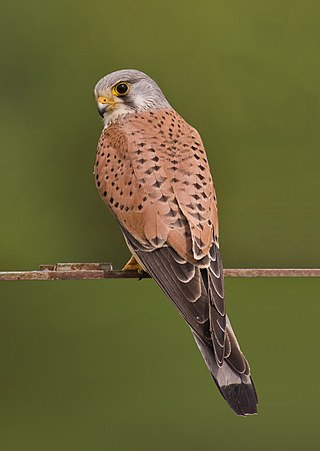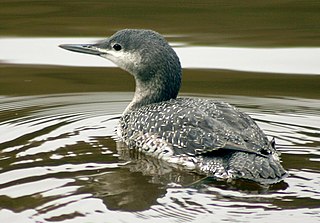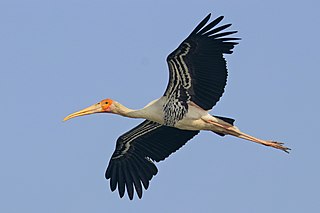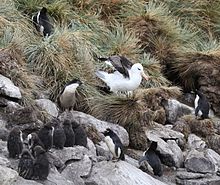
Penguins are a group of aquatic flightless birds from the family Spheniscidae of the order Sphenisciformes. They live almost exclusively in the Southern Hemisphere: only one species, the Galápagos penguin, is found north of the Equator. Highly adapted for life in the ocean water, penguins have countershaded dark and white plumage and flippers for swimming. Most penguins feed on krill, fish, squid and other forms of sea life which they catch with their bills and swallow whole while swimming. A penguin has a spiny tongue and powerful jaws to grip slippery prey.

Birds of prey or predatory birds, also known as raptors, are hypercarnivorous bird species that actively hunt and feed on other vertebrates. In addition to speed and strength, these predators have keen eyesight for detecting prey from a distance or during flight, strong feet with sharp talons for grasping or killing prey, and powerful, curved beaks for tearing off flesh. Although predatory birds primarily hunt live prey, many species also scavenge and eat carrion.

Amniotes are tetrapod vertebrate animals belonging to the clade Amniota, a large group that comprises the vast majority of living terrestrial and semiaquatic vertebrates. Amniotes evolved from amphibious stem tetrapod ancestors during the Carboniferous period and further diverged into two groups, namely the sauropsids and synapsids, an event that marks the appearance of Amniota, according to the definition established under the PhyloCode. This basal divergence within Amniota has been dated by molecular studies at 310–329 Ma or 312–330 Ma, but the presence of Hylonomus at Joggins implies a minimal age of about 317 Ma. A fossilized birth-death process study of early amniotes suggested an age of 322–340 Ma. Amniotes are distinguished from the other living tetrapod clade — the non-amniote lissamphibians — by the development of three extraembryonic membranes, thicker and keratinized skin, and costal respiration. Additional unique features are the presence of adrenocortical and chromaffin tissues as a discrete pair of glands near their kidneys, which are more complex, the presence of an astragalus for better extremity range of motion, the diminished role of skin breathing, and the complete loss of metamorphosis, gills, and lateral lines.

Procolophonia is an extinct suborder (clade) of herbivorous reptiles that lived from the Middle Permian till the end of the Triassic period. They were originally included as a suborder of the Cotylosauria but are now considered a clade of Parareptilia. They are closely related to other generally lizard-like Permian reptiles such as the Millerettidae, Bolosauridae, Acleistorhinidae, and Lanthanosuchidae, all of which are included under the Anapsida or "Parareptiles".

Neoaves is a clade that consists of all modern birds with the exception of Palaeognathae and Galloanserae. This group is defined in the PhyloCode by George Sangster and colleagues in 2022 as "the most inclusive crown clade containing Passer domesticus, but not Gallus gallus". Almost 95% of the roughly 10,000 known species of extant birds belong to the Neoaves.

Alligatoroidea is one of three superfamilies of crocodylians, the other two being Crocodyloidea and Gavialoidea. Alligatoroidea evolved in the Late Cretaceous period, and consists of the alligators and caimans, as well as extinct members more closely related to the alligators than the two other groups.

Aequornithes, or core water birds, are defined in the PhyloCode as "the least inclusive crown clade containing Pelecanus onocrotalus and Gavia immer".

Cariamiformes is an order of primarily flightless birds that has existed for over 50 million years. The group includes the family Cariamidae (seriemas) and the extinct families such as Phorusrhacidae, Bathornithidae, Idiornithidae and Ameghinornithidae. Extant members (seriemas) are only known from South America, but fossils of many extinct taxa are also found in other continents including Europe and North America. Though traditionally considered a suborder within Gruiformes, both morphological and genetic studies show that it belongs to a separate group of birds, Australaves, whose other living members are Falconidae, Psittaciformes and Passeriformes.

Eufalconimorphae is a proposed clade of birds, consisting of passerines, parrots, falcons, caracaras, and forest falcons. It has whole-genome DNA support. This clade was defined in the PhyloCode by George Sangster and colleagues in 2022 as "the least inclusive crown clade containing Falco subbuteo and Passer domesticus". Eufalconimorphae birds are characterized by their strong and hooked beaks, sharp talons, and powerful wings. They have excellent eyesight, which allows them to spot their prey from great distances. The Eufalconimorphae is noted to produce aerodynamic force during the upstroke of flight to help create a vertical flight pattern.
Hanosaurus is an extinct genus of marine reptiles that existed during the Triassic period in what is now China. The type species is Hanosaurus hupehensis. It was a small animal, with specimens measuring 79.4 cm (31.3 in) long in total body length, which likely fed on soft-bodied prey.

Afroaves is a clade of birds, consisting of the kingfishers and kin (Coraciiformes), woodpeckers and kin (Piciformes), hornbills and kin (Bucerotiformes), trogons (Trogoniformes), cuckoo roller (Leptosomiformes), mousebirds (Coliiformes), owls (Strigiformes), raptors (Accipitriformes) and New World vultures (Cathartiformes). The most basal clades are predatory, suggesting the last common ancestor of Afroaves was also a predatory bird. This group was defined in the PhyloCode by George Sangster and colleagues in 2022 as "the least inclusive crown clade containing Accipiter nisus, Colius colius, and Picus viridis, but not Passer domesticus".

Telluraves is a recently defined clade of birds defined by their arboreality. Based on most recent genetic studies, the clade unites a variety of bird groups, including the australavians as well as the afroavians. This grouping was defined in the PhyloCode by George Sangster and colleagues in 2022 as "the least inclusive crown clade containing Accipiter nisus and Passer domesticus". They appear to be the sister group of the Phaethoquornithes.

Phaethoquornithes is a clade of birds that contains Eurypygimorphae and Aequornithes, which was first recovered by genome analysis in 2014. Members of Eurypygimorphae were originally classified in the obsolete group Metaves, and Aequornithes were classified as the sister taxon to Musophagiformes or Gruiformes.

Archelosauria is a clade grouping turtles and archosaurs and their fossil relatives, to the exclusion of lepidosaurs. The majority of phylogenetic analyses based on molecular data have supported a sister-group relationship between turtles and archosaurs. On the other hand, Archelosauria had not been historically supported by most morphological analyses, which have instead found turtles to either be descendants of parareptiles, early-diverging diapsids outside of Sauria, or close relatives of lepidosaurs within the clade Ankylopoda. Some recent morphological analyses have also found support for Archelosauria.

Aequorlitornithes is a clade of waterbirds recovered in a comprehensive genomic systematic study using nearly 200 species in 2015. It contains the clades Charadriiformes, Mirandornithes and Phaethoquornithes. Previous studies have found different placement for the clades in the tree.

The genomic evolution of birds has come under scrutiny since the advent of rapid DNA sequencing, as birds have the smallest genomes of the amniotes despite acquiring highly derived phenotypic traits. Whereas mammalian and reptilian genomes range between 1.0 and 8.2 giga base pairs (Gb), avian genomes have sizes between 0.91 Gb and 1.3 Gb. Avian genomes reflect the action of natural selection and are the basis of their phenotypes, reflected in their morphology and behaviour, which have evolved significantly since their divergence from other archosaurian, diapsid, and amniotic lineages.

Klallamornis is an extinct genus of Plotopteridae, a family of large, flightless birds related to modern cormorants, darters, gannets, and boobies. This genus included the largest North American plotopterids. Its remains can be found in Late Eocene to Late Oligocene rocks from the Makah Formation, the overlying Pysht Formation and the Lincoln Creek Formation of the State of Washington. During its existence, Klallamornis was the largest plotopterid on the North American continent. The first fossil remains attributed to the taxon were collected in 1983, although the genus wasn't described until 2016.

Hieraves is a clade of telluravian birds named by Wu et al. (2024) that includes the orders Strigiformes (owls), Cathartiformes, and Accipitriformes. In the past, either owls, New World vultures, and hawks were found to be basal outgroups with respect to Coraciimorphae inside Afroaves, or Accipitriformes and Cathartiformes were recovered as a basal clade in respect to the rest of the members of Telluraves. Houde and Braun (2019) found support for Hieraves, but they were found to be the sister group to Coraciimorphae and Australaves. The analysis of Wu et al. (2024) has found Hieraves to be the sister clade to Australaves. Stiller et al. (2024) found Hieraves to be basal to Afroaves.

Litusilvanae is a proposed clade of birds, position as the sister clade to Aequorlitornithes. This clade comprises Gruimorphae and Strisores. While different lines of evidence from molecular, morphology and the fossil record has found support in the clades Gruimorphae and Strisores Wu et al. (2024) was the first to find support in such a novel sister group relationship between these two taxa.




















